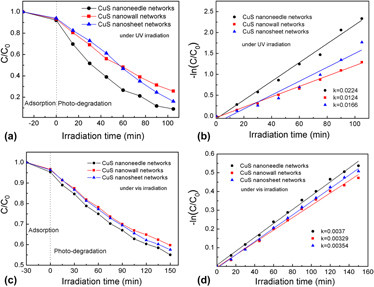Crossref Citations
This article has been cited by the following publications. This list is generated based on data provided by
Crossref.
Shen, Zhenguang
Zhao, Zengying
Qian, Jingwen
Peng, Zhijian
and
Fu, Xiuli
2016.
Synthesis of WO3−x nanomaterials with controlled morphology and composition for highly efficient photocatalysis.
Journal of Materials Research,
Vol. 31,
Issue. 8,
p.
1065.
Coughlan, Claudia
Ibáñez, Maria
Dobrozhan, Oleksandr
Singh, Ajay
Cabot, Andreu
and
Ryan, Kevin M.
2017.
Compound Copper Chalcogenide Nanocrystals.
Chemical Reviews,
Vol. 117,
Issue. 9,
p.
5865.
Lv, Zhenlong
Cui, Hongling
Huang, Haiming
Li, Xiaohong
Wang, Hui
and
Ji, Guangfu
2017.
Study of the electronic, bonding, elastic and acoustic properties of covellite via first principles.
Journal of Alloys and Compounds,
Vol. 692,
Issue. ,
p.
440.
Qian, Jingwen
Peng, Zhijian
Peng, Min
Li, Hong
Wang, Meng
Li, Hanqing
and
Fu, Xiuli
2017.
Carbon fibers@semiconductors nanostructures core–shell composites: Facile strategy for highly efficient solar-driven photocatalysts.
Journal of Catalysis,
Vol. 353,
Issue. ,
p.
325.
Wang, Meng
Peng, Zhijian
Qian, Jingwen
Li, Hong
Zhao, Zengying
and
Fu, Xiuli
2018.
Data on novel C fibers@MoSe2 nanoplates core–shell composite for highly efficient solar-driven photocatalytically degrading environmental pollutants.
Data in Brief,
Vol. 17,
Issue. ,
p.
842.
Wang, Meng
Peng, Zhijian
Li, Hong
Zhao, Zengying
and
Fu, Xiuli
2018.
C fibers@MoO2 nanoparticles core–shell composite: Highly efficient solar-driven photocatalyst.
Journal of Materials Research,
Vol. 33,
Issue. 6,
p.
685.
Zhang, Jianchao
Shi, Rongrong
Zhang, Chen
Li, Lingyun
Mei, Jiaming
and
Liu, Shengqing
2018.
Solvothermal synthesis of manganese sulfides and control of their phase and morphology.
Journal of Materials Research,
Vol. 33,
Issue. 24,
p.
4224.
Zammouri, Lobna
Aboulaich, Abdelhay
Capoen, Bruno
Bouazaoui, Mohamed
Sarakha, Mohamed
Stitou, Mostafa
and
Mahiou, Rachid
2019.
Synthesis of YAG:Ce/ZnO core/shell nanoparticles with enhanced UV-visible and visible light photocatalytic activity and application for the antibiotic removal from aqueous media.
Journal of Materials Research,
Vol. 34,
Issue. 08,
p.
1318.
Fan, Yunchang
Li, Yingcun
Han, Xiaojiang
Wu, Xiaojie
Zhang, Lina
and
Wang, Qiang
2019.
Facile Preparation of CuS Nanoparticles from the Interfaces of Hydrophobic Ionic Liquids and Water.
Molecules,
Vol. 24,
Issue. 20,
p.
3776.
Zhao, Liangyan
Chen, Xiaohong
Liu, Ping
Li, Wei
Ma, Fengcang
He, Daihua
and
Li, Jinzhang
2019.
Effect of yttrium on the electrical and mechanical properties of in situ synthesized CNTs/CuCr composites.
Journal of Materials Research,
Vol. 34,
Issue. 15,
p.
2590.
Zhang, Fan
Zhuang, Hua-Qiang
Zhang, Wenming
Yin, Jun
Cao, Fu-Hu
and
Pan, Yun-Xiang
2019.
Noble-metal-free CuS/CdS photocatalyst for efficient visible-light-driven photocatalytic H2 production from water.
Catalysis Today,
Vol. 330,
Issue. ,
p.
203.
Zhang, Xiaohui
Liu, Minghuan
Kang, Zewen
Wang, Bingqing
Wang, Bo
Jiang, Fuyi
Wang, Xiansong
Yang, Da-Peng
and
Luque, Rafael
2020.
NIR-triggered photocatalytic/photothermal/photodynamic water remediation using eggshell-derived CaCO3/CuS nanocomposites.
Chemical Engineering Journal,
Vol. 388,
Issue. ,
p.
124304.
Qi, Jiaxin
Wen, Jinxi
Wang, Qin
Jin, Xiu
and
Zhou, Xingping
2020.
Preparation and photocatalytic properties of hexagonal and orthogonal CuS micro-nanoparticles by an oil-water interface method.
Materials Chemistry and Physics,
Vol. 255,
Issue. ,
p.
123629.
Ahmad, Nafis
Alshehri, A.M.
Khan, Z.R.
Almahdawi, S.A.M.
Shkir, Mohd
Hasan, P.M.Z.
Alshahrie, Ahmed
Khan, Firoz
and
Al-Ahmed, Amir
2022.
An investigation on structural, optical and enhanced third order nonlinear optical properties of facilely synthesized Ce:CuS nanosheets.
Inorganic Chemistry Communications,
Vol. 139,
Issue. ,
p.
109363.





